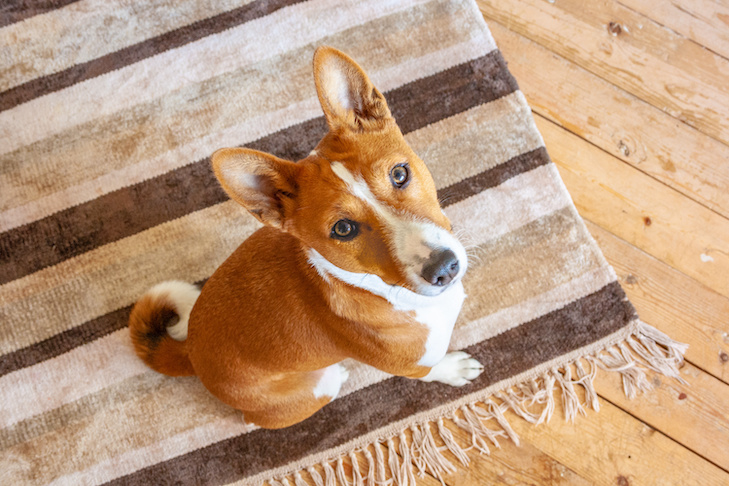If you have an active, energetic dog, you’ve probably witnessed the combination of an excited dog and polished wood floors. You’ve likely seen a similar scenario: your dog runs across the wood floor to bark at someone who rang the doorbell, and their hind legs slide out from underneath them, causing them to fall.
However, if they try to get up, they keep falling down, and this happens over and over again, a slippery floor may not be the cause. Take note if their legs seem to be flying in different directions, losing control, and continuously falling. It could be a sign that your dog might have a condition known as ataxia.
What Is Ataxia in Dogs?
Ataxia is a condition that can occur in dogs, but can also affect humans. It happens when you can’t control voluntary muscle movements, as with some central nervous system disorders. When the cerebellum, the part of the brain that coordinates movement, isn’t functioning normally, your dog’s movements will look awkward or out of order. Although they are uncoordinated, it doesn’t mean the muscle is weak.

Ataxia is often confused with muscle weakness (paresis), but according to the Head of Neurosurgery at the Ohio State University College of Veterinary Medicine, Dr. Ronaldo C. da Costa, DMV, MSc, PhD, DACVIM, they are not interchangeable. Ataxia affects your dog’s coordination without affecting their strength. Paresis, on the other hand, only affects strength.
Symptoms of Ataxia in Dogs
If your dog suffers from ataxia, the most common and noticeable symptom is a change in their gait, making them appear unsteady, almost like a human when drunk. But regardless of the type of ataxia your dog may have, veterinary neurologists divide canine ataxia into three categories, each with slightly different symptoms depending on where in the nervous system the problem occurs.
Cerebellar Ataxia
Any disease that affects the cerebellum, such as canine distemper, strokes, or brain tumors, may cause cerebellar ataxia. When the spinal cord is damaged, it’s called spinocerebellar ataxia (SCA). Research of certain breeds, including the Spinone Italiano, suggests that SCA may be inherited from a recessive gene. The Orthopedic Foundation for Animals (OFA) recommends testing certain breeds of terriers, such as the Russell Terrier, Parson Russell Terrier, Toy Fox Terrier, and Smooth Fox Terrier, to see if they carry the gene. The link is not proven to be direct to this recessive gene, but continued research is being done to rule out factors that could cause SCA.

Symptoms include:
- Goose-stepping (lifting legs in an exaggerated manner called hypermetria)
- Head tremors that worsen when the dog reaches to pick up toys or drink
- Legs flying in every direction when running
- Frequent loss of balance and falling
- Dragging toes on the ground
Proprioceptive Ataxia
Proprioceptive ataxia causes a dog to be unaware of where their legs are in space, known as proprioception. As a result, it becomes hard for the dog to move normally. These conditions are often due to a spinal cord lesion and can present themselves in many ways. This can happen because of compression of the dog’s spinal cord from a bulging disc, mass, tumor, or nerve injury, but it could also be a bleeding blood vessel or clot in the spinal column.
Symptoms include:
- Stumbling
- Dragging their toes
- Paws bending under when walking, causing the dog to walk on their knuckles (loss of proprioception)
- Swaying
Vestibular Ataxia
Vestibular ataxia occurs when the inner ear or brainstem isn’t functioning normally and interferes with a dog’s balance. Potential causes include hypothyroidism, ear infections, inner ear or brainstem tumors, head or ear trauma, strokes, infections caused by canine distemper, inflammation of the brain, thiamine deficiency, and metronidazole toxicity. Although a dog at any age may be affected, senior dogs sometimes get acute vestibular disease or idiopathic vestibular disease. This appears when a dog suddenly becomes unbalanced. It usually doesn’t get worse and often improves quickly. This is also caused by an issue in the dog’s middle or inner ear.

Symptoms include:
- Head tilted to one side
- Uncoordinated gait
- Circling, usually toward the side of the lesion (unless the cause is cerebellar, in which case the circling is often contralateral, meaning it’s related to the other side of the body)
- Eyes moving jerkily from side to side, up and down, or circling (a condition called nystagmus)
- Inability to stand and repeatedly rolling over to one side
- Excessive salivation
- Moving in circles in the same direction
Why Do Dogs Get Ataxia?
Ataxia is caused by an injury, infection, inflammation, or toxin that affects the dog’s nervous system. In some cases, ataxia happens because of a neurological disease or infection. Some examples of these include encephalitis, tumors, spinal cord disease, head trauma, inner-ear infections, vertebral infections, anaplasmosis, or canine distemper.
But ataxia can also be caused by other things, not just neurological diseases or infections. Metabolic diseases such as hypoglycemia (low blood sugar), toxins such as xylitol, marijuana, and macadamia nuts, and drugs such as phenobarbital or metronidazole can also cause ataxia.
When Should You Call the Vet?
You should call your veterinarian any time your dog suddenly seems unbalanced, their gait changes, they can’t stand up, or they hold their head or body in an unusual way. Since there are so many causes of ataxia, the vet will need to perform a series of tests before diagnosing the condition. This may include a physical exam, blood and urine tests, X-rays of your dog’s back or head, a CT scan, or a cerebrospinal fluid tap.
Then, they will determine the best course of treatment for your dog. In some cases, you may be referred to a veterinary neurologist. Depending on the cause of the condition, treatment can range from antibiotics to anti-inflammatories to surgery, chemotherapy, or radiation. Physical therapy with a canine rehabilitation therapist may also be recommended.
Will My Dog Get Better?
The prognosis for ataxia will vary based on the underlying cause and type of ataxia. Some cases may improve, some may stabilize, and others can get worse.

You can help your ataxic dog have a good quality of life. In addition to your veterinarian’s suggestions on managing pain, you will need to provide supportive and safe care. If your dog has ataxia, you should support them on stairs and use dog gates to limit their use of stairs when possible. Block off any sharp corners of furniture in your home, and lay carpets down over slippery floors, like wood, to limit loss of balance. Depending on how bad and what kind of ataxia your dog has, they might need a sling or towel to help them balance when they’re pooping or peeing outside. If your dog suffers from head tremors or tilts, feeding them by hand will help ensure that they are still well-fed and getting the nutrients they need. Your dog shouldn’t be left alone or unsupervised, especially near bodies of water or swimming pools, as they could lose their balance and fall in.
Talk to your vet about any concerns you may have as soon as symptoms arise. Because there are so many causes of ataxia, allowing your vet to rule out causes early on will help your dog get the best care possible.
This article is intended solely as general guidance, and does not constitute health or other professional advice. Individual situations and applicable laws vary by jurisdiction, and you are encouraged to obtain appropriate advice from qualified professionals in the applicable jurisdictions. We make no representations or warranties concerning any course of action taken by any person following or otherwise using the information offered or provided in this article, including any such information associated with and provided in connection with third-party products, and we will not be liable for any direct, indirect, consequential, special, exemplary or other damages that may result, including but not limited to economic loss, injury, illness or death.

